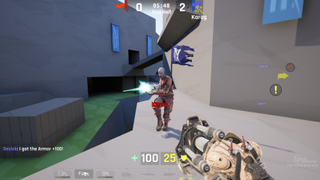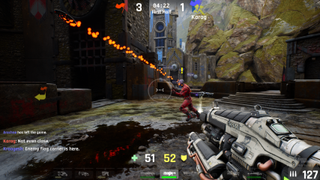It's time to pay attention to the new Unreal Tournament
Epic talks about the state of Unreal Tournament, two years in: frenetic, fun, and still very unfinished.

Flag Run: a new mode to compete with CS:GO and Overwatch
Epic already has arena shooter staples like team deathmatch down—those aren’t going anywhere in the new UT. Over the past few months the team has been focused on what it hopes will be the defining mode of this new Unreal Tournament—something to set it apart from its own heritage and competing shooters like Overwatch.
“When you’re playing Counter-Strike, there’s a mode that’s the mode,” Polge says. “If you talk about Counter-Strike, people know what you’re talking about. That’s what we’re trying to build. Something that feels like UT in pace, has elements of deathmatch and capture the flag that we love, packaged in a way that’s really excited for players. It has a sense of progression in terms of team play and learning to play better together, lots of skill, and strategy to learn.”
That mode is currently called Flag Run. Attackers have a flag that they’re trying to shepherd to the defenders’ base, but there’s a deathmatch twist: defenders have a limited life pool, so attackers can win by scoring enough kills. The mode is balanced so that attackers tend to win more often, but there’s a twist there, too. They get 1-3 stars based on how quickly they score within the five minute match, so defenders can still succeed by holding out until the last possible second.
“Because it’s not binary win or lose, it helps the ebb and flow of combat a tremendous amount,” Estep says. “You get big peaks of amazing moments right before each of those tiers happen.”

The level designers have mainly been focusing on building new maps to showcase UT’s movement system and the new mode, which Polge says has been a challenge. Because of the strict time limit and the defenders’ limited pool of lives, it’s a tricky balance of size and layout. How much of a break should the defenders get for fending off an attack? How much distance should attackers have to cover?
The scale of characters in relation to maps can have a huge impact on the feel of a shooter, too, but it’s a factor most gamers probably never think about. Polge explained that UT2K4’s double jumping and wall dodging, while fun, made it an airborne game with a skewed scale.
Both Estep and Polge came back to “expression of movement” as vital to what makes UT, UT.
“That did two things,” he says. “It made it a very hitscan-dominated game. People were mostly in the air, so you couldn’t really use rockets and stuff very effectively against them. It also meant that our levels were way over-scaled compared to reality, so you looked like a bunch of little midgets walking around in these giant spaces. We liked the freedom of the movement and the cool things it allowed … but we wanted to still have that without having levels that didn’t feel like real places.”
The biggest gaming news, reviews and hardware deals
Keep up to date with the most important stories and the best deals, as picked by the PC Gamer team.
Polge's solution was a slide move in place of the double jump. The community will likely continue to argue over sliding and double jumping and wall running long after Unreal Tournament is released, but perhaps that’s how it should be. Arena shooters are about movement and map control above all else (aside from aiming, natch), and both Estep and Polge came back to “expression of movement” as vital to what makes UT, UT.
“I play a ton of Overwatch,” says Estep. “I love that game, but the amount of options that one player has in UT, and the way they can express themselves, not only through movement, but through weapon switching, combinations between weapons, there’s nothing out there that goes to the depth of what we possess right now … It seems like things are trending towards the rock-paper-scissors hard counters, as opposed to: ‘let’s let this moment unfold, and play out, and see how the skill really lets things fall.’”
In terms of modernizing Unreal Tournament or making it more competitive with hugely popular shooters like Overwatch and CS:GO, Polge made a distinction between in-the-moment depth and out-of-the-moment depth. “The problem is that in a game like UT that’s super fast-paced and intense, you can only have so much in-the-moment depth before it’s overwhelming,” he says. “We’re trying to add higher level strategic depth.”
At some point after Unreal Tournament hits alpha, Polge hopes to staff up and go into full production to finish the game more quickly. I don’t know if UT will be “finished” in 2017, but it’s hard to be impatient when the game is playable at this very moment, and already a great arena shooter, even half finished.
A new build was released on Monday, reworking the HUD and armor system, and making some small changes to weapon balance and movement values. Fans are already complaining it’s too slow.
Thumbnail image via UT forumgoer HenrikRyosa.

Wes has been covering games and hardware for more than 10 years, first at tech sites like The Wirecutter and Tested before joining the PC Gamer team in 2014. Wes plays a little bit of everything, but he'll always jump at the chance to cover emulation and Japanese games.
When he's not obsessively optimizing and re-optimizing a tangle of conveyor belts in Satisfactory (it's really becoming a problem), he's probably playing a 20-year-old Final Fantasy or some opaque ASCII roguelike. With a focus on writing and editing features, he seeks out personal stories and in-depth histories from the corners of PC gaming and its niche communities. 50% pizza by volume (deep dish, to be specific).
Most Popular


